https://en.wikipedia.org/wiki/Bacon
Bacon
From Wikipedia, the free encyclopedia
This article is about the meat. For other uses, see
Bacon (disambiguation).
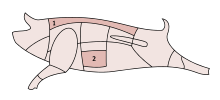
(1) fatback (2) pork belly

A strip of bacon
Bacon is a meat product prepared from a
pig and usually
cured.
[1][2] It is first cured using large quantities of salt,
[2] either in a
brine or in a dry packing; the result is
fresh bacon (also known as
green bacon).
[3] Fresh bacon may then be further dried for weeks or months in cold air, or it may be
boiled or
smoked.
[1] Fresh and dried bacon is typically cooked before eating, often by frying. Boiled bacon is ready to eat, as is some smoked bacon, but may be cooked further before eating.
Bacon is prepared from several different
cuts of meat. It is usually made from side and back cuts of pork,
[4] except in the
United States and
Canada, where it is most commonly prepared from
pork belly (typically referred to as "streaky", "fatty", or "American style" outside of the US and Canada). The side cut has more meat and less fat than the belly. Bacon may be prepared from either of two distinct back cuts:
fatback, which is almost pure fat, and
pork loin, which is very lean. Bacon-cured pork loin is known as
back bacon.

Uncooked rashers of streaky pork belly bacon

Packaged
smoked bacon

Raw bacon in a pan
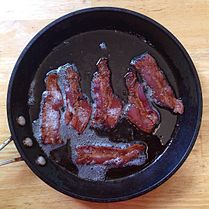
The same bacon, cooked
Bacon may be eaten smoked, boiled, fried, baked, or grilled and eaten on its own, as a side dish (particularly in
breakfasts in North America) or used as a minor ingredient to flavour dishes (e.g., the
Club sandwich). Bacon is also used for
barding and larding roasts, especially game, including
venison and
pheasant. The word is derived from the
Old High German bacho, meaning "buttock", "ham" or "side of bacon", and cognate with the
Old French bacon.
[5][6]
In contrast to the practice in the United States, in continental Europe these cuts of the pig are usually not smoked, but are instead used primarily in cubes (
lardons) as a cooking ingredient, valued both as a source of fat and for its flavour. In Italy, this product is called
pancetta and is usually cooked in small cubes or thinly sliced as part of an
antipasto.
Meat from other animals, such as
beef,
lamb,
chicken,
goat, or
turkey, may also be cut, cured, or otherwise prepared to resemble bacon, and may even be referred to as "bacon".
[7] Such use is common in areas with significant
Jewish and
Muslim populations, both of which prohibit the consumption of pigs.
[8] The
USDA defines bacon as "the cured belly of a swine carcass"; other cuts and characteristics must be separately qualified (e.g., "smoked pork loin bacon"). For safety, bacon may be treated to prevent
trichinosis,
[9] caused by
Trichinella, a parasitic
roundworm which can be destroyed by heating, freezing, drying, or smoking.
[10]
Bacon is distinguished from
salt pork and
ham by differences in the brine (or dry packing). Bacon brine has added curing ingredients, most notably
sodium nitrite, and occasionally
potassium nitrate (
saltpeter);
sodium ascorbate or
erythorbate are added to accelerate curing and stabilise colour. Flavourings such as
brown sugar or
maple are used for some products. Sodium polyphosphates, such as
sodium triphosphate, may be added to make the produce easier to slice and to reduce spattering when the bacon is pan-fried. Today, a brine for ham, but not bacon, includes a large amount of sugar. Historically, "ham" and "bacon" referred to different cuts of meat that were brined or packed identically, often together in the same barrel.
Contents
Curing and smoking bacon
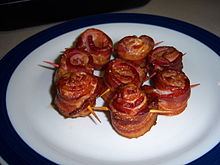
Smoke cured bacon, then cooked with additional hickory smoke
Bacon is cured through either a process of injecting with or soaking in brine or using plain salt (dry curing).
[2]
In America, bacon is usually
cured and
smoked, and different flavours can be achieved by using various types of wood, or rarely
corn cobs;
peat is sometimes used in the
United Kingdom. This process can take up to eighteen hours, depending on the intensity of the flavour desired.
The Virginia Housewife (1824), thought to be one of the earliest American cookbooks, gives no indication that bacon is ever
not smoked, though it gives no advice on flavouring, noting only that care should be taken lest the fire get too hot.
[11] In early American history, the preparation and smoking of bacon (like the making of
sausage) seems to have been a gender-neutral process, one of the few food-preparation processes not divided by gender.
[12]
In the
United Kingdom and
Ireland, smoked and unsmoked varieties are equally common, unsmoked being referred to as
green bacon.
[3] The term
streaky bacon refers to belly bacon, due to the prominence of the bands of fat.
[13]
Cuts of bacon
Rashers differ depending on the
primal cut from which they are prepared:
[14][15]

Cooked rasher of streaky bacon
- Side bacon, or streaky bacon, comes from pork belly.[14][15] It is very fatty with long layers of fat running parallel to the rind.[14][16][17] This is the most common form of bacon in the United States.[14] Pancetta is Italian streaky bacon, smoked or aqua (unsmoked), with a strong flavour.[14][15] It is generally rolled up into cylinders after curing.[14][15]

Back bacon, ready for cooking
- Middle bacon, from the side of the animal, is intermediate in cost, fat content, and flavour between streaky bacon and back bacon.[14]
- Back bacon (rashers, sometimes called Canadian bacon in the United States especially when referred to as a pizza topping) comes from the loin in the middle of the back of the pig.[14][16][18] It is a very lean, meaty cut of bacon, with less fat compared to other cuts.[15] It has a ham-like texture.[14] Most bacon consumed in the United Kingdom is back bacon.[14][19]
- Cottage bacon is thinly sliced lean pork meat from a shoulder cut that is typically oval shaped and meaty.[14] It is cured and then sliced into round pieces for baking or frying.[14]
- Jowl bacon is cured and smoked cheeks of pork.[20] See Guanciale.

Sliced jowl bacon
- Slab bacon is side bacon that is not sliced.[15] It generally has the rind still intact, and usually has a medium to very high fraction of fat.[15] It is made from the belly and side cuts, and from fatback.[14] Slab bacon is not to be confused with salt pork, which is prepared from the same cuts, but is not cured.[14]
Bacon joints include the following:
- Collar bacon is taken from the back of a pig near the head.[14][21]
- Hock, from the hog ankle joint between the ham and the foot.[14][22] See Ham hock.
- Gammon, from the hind leg,[14] traditionally "Wiltshire cured".[23] See Gammon (meat).
- Picnic bacon is from the picnic cut, which includes the shoulder beneath the blade.[14][24] It is fairly lean, but tougher than most pork cuts.[14]
Process
First,
pork bellies are sorted by size and fat percentage.
[25] They are then placed into a large machine that rotates (often called a tumbler).
[26] This softens the bellies, which makes it easier to remove the rinds. The bellies are then cut, either manually or mechanically, to remove the skin from the meat. The skins may be used to be processed into
pork rinds. The bacon is then treated by a
brine solution.
[25][26] The brine solution may contain the flavorings, or the flavorings may be added later. After being brined, the bacon is
smoked. Depending on where the bacon is made, the smoking process is different. The bacon is then cooked in an oven and soon after chilled for a few days. The cooling makes the meat firm which makes it easier to slice.
[26] After being cooled, the bacon is sliced into strips. The bacon is then cooked. The fat that cooks off the bacon is sometimes collected to be used for things like gravy and pet foods.
[26] The bacon strips are then ready for consumption. If the bacon is made for
commercial use then the strips are packaged.
[26]
Around the world

Bacon and egg on toast,
garnished with a strawberry
Traditionally, the skin is left on the cut and is known as 'bacon rind',
[27] but rindless bacon is also common throughout the English-speaking world. The meat may be bought smoked or unsmoked. Bacon is often served with
eggs and
sausages as part of a
full breakfast.
[28]
Australia and New Zealand
Middle bacon is the most common variety and is sold in 'rashers'. Middle bacon includes the streaky, fatty section along with the loin at one end. In response to increasing consumer
diet-consciousness, some
supermarkets also offer the loin section only. This is sold as 'short cut bacon' and is usually priced slightly higher than middle bacon. Both varieties are usually available with the rind removed.
[29]
Canada

Roasted peameal bacon with a maple glaze at the St. Lawrence Market in
Toronto, Ontario, Canada.
An individual piece of bacon is a 'slice' or 'strip'. In Canada:
- The term bacon on its own or, more specifically, side bacon[30] typically refers to bacon from the pig's belly.
- Back bacon refers to either smoked or unsmoked bacon cut from the boneless eye of pork loin;[30] this is called 'Canadian bacon' in the United States when cut into a thick medallion shape.
- Peameal bacon is back bacon, brined and coated in fine cornmeal (historically, it was rolled in a meal made from ground dried peas).[30]
- Bacon is often eaten in breakfasts, such as with cooked eggs or pancakes.
Germany

Above: Smoked fatback (Rückenspeck)
German smoked and baked pork belly used for cold cuts

Tyrolean Speckknödelssuppe including bacon cubes
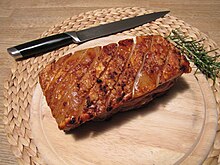
Grilled pork belly, Wammerl in
Bavarian dialect
Some of the meanings of bacon overlap with the German language term
Speck. Germans use the term
bacon explicitly for
Frühstücksspeck ('breakfast
Speck') which are cured or smoked pork slices. Traditional German
cold cuts favor ham over bacon, however "Wammerl" (grilled pork belly) remains popular in Bavaria.
Small bacon cubes (called "Grieben" or "Grammerln" in Austria and southern Germany) have been a rather important ingredient of various southern German dishes. They are used for adding flavor to soups and salads and for speck dumplings and various noodle and potato dishes. Instead of preparing them at home from larger slices, they began to be sold ready made as
convenience foods recently as "Baconwürfel" ("bacon cubes") in German retail stores.
Japan
In Japan, bacon (ベーコン)
[31] is pronounced "bēkon". It is cured and smoked belly meat as in the US, and is sold in either regular or half length sizes. Bacon in Japan is different from that in the US in that the meat is not sold raw, but is processed, precooked and has a ham-like consistency when cooked.
[32] Uncured belly rashers, known as bara (バラ), are very popular in Japan and are used in a variety of dishes (e.g.
yakitori and
yakiniku).
United Kingdom and Ireland
A rasher of bacon is a thin slice;
[4] rashers were called
collops in the sixteenth century. Bacon is usually described as either streaky or back:
- The term bacon on its own does not specify the cut but typically refers to back bacon.
- Bacon from the pork belly, with streaks of meat and fat, is referred to as 'streaky bacon'.
- Bacon from the back of the pig is referred to as 'back bacon', and usually includes a streaky bit and a lean oval bit.
- Middle cuts with an eye of meat and an extended streaky section are common.
- Heavily trimmed back cuts which may consist of just the eye of meat are available.
Bacon may be cured in several ways; in particular it may be described as smoked or unsmoked. Many ways of curing add water to the meat; bacon sold as "dry cured" does not have added water. For example, in a shop a particular type may be described as "dry-cured unsmoked back bacon".
[33]
Grilled
[4] or fried bacon rashers are included in the traditional
full breakfast, which varies slightly from country to country ("full Scottish", etc.).
United States
A side of unsliced bacon was once known as a 'flitch';
[34] it is now known as a 'slab'.
[35] An individual rasher of bacon is known as a 'slice' or 'strip'. The term 'rasher of bacon' is occasionally encountered (e.g., on restaurant menus) to mean a serving of bacon (typically several slices).
[4]
American bacons include varieties smoked with
hickory or
corncobs and flavourings such as
red pepper,
maple,
brown sugar,
honey,
molasses, and occasionally
cinnamon. They vary in sweetness and saltiness and come from the
Ozarks,
New England, and the
upper South (mainly
Kentucky,
North Carolina,
Tennessee and
Virginia).
[36]
- The term 'bacon' on its own generally refers to strip bacon from the belly meat of the pig, which is the most popular type of bacon sold in the US.
- 'Canadian Bacon' or 'Canadian-style bacon' is made from the pork loin,[37] usually the lean ovoid portion (longissimus muscle or loineye).[24] It also can be made from the sirloin portion of the loin (gluteal muscles), but must be labelled appropriately. Similar products are used as less expensive substitutes.
- 'Streak o' lean', a Southern bacon made from fatback.[38]
Addictive taste
Arun Gupta of
The Indypendent has pointed out how the food industry adds flavorings to bacon, using the example of McDonald's, which uses six different
umami additives to elicit an addictive
neurochemical response.
[39] "The chain lards on bacon", which give foods a "high flavor profile" creating a "one-of-a-kind product that has no taste substitute."
[40] This led
Dr. David Kessler, author of
The End of Overeating, to note how the standard joke in the restaurant chain industry goes, "When in doubt, throw cheese and bacon on it."
[40]
Bacon mania
Main article:
Bacon mania
There is: bacon ice cream; bacon-infused vodka; deep-fried bacon; chocolate-dipped bacon; bacon-wrapped hot dogs filled with cheese (which are fried, then battered and fried again); brioche bread pudding smothered in bacon sauce; hard-boiled eggs coated in mayonnaise encased in bacon—called, appropriately, the "heart attack snack"; bacon salt; bacon doughnuts, cupcakes and cookies; bacon mints; "baconnaise," which
Jon Stewart described as "for people who want to get heart disease but [are] too lazy to actually make bacon";
Wendy's "Baconnator"—six strips of bacon mounded atop a half-pound cheeseburger—which sold 25 million in its first eight weeks; and the outlandish
bacon explosion—a barbecued meat brick composed of 2 pounds of bacon wrapped around 2 pounds of sausage.

Chocolate-covered bacon on a stick
The United States and Canada have seen an increase in the popularity of bacon and bacon related recipes, dubbed "
bacon mania". The sale of bacon in the U.S. has increased significantly since 2011. Sales climbed 9.5% in 2013, making it an all-time high of nearly $4 billion in U.S. In a survey conducted by Smithfield, 65% of Americans would support bacon as their "national food."
[41] Dishes such as
bacon explosion,
chicken fried bacon, and
chocolate-covered bacon have been popularised over the internet,
[42] as has using candied bacon. Recipes spread quickly through both countries' national
media, culinary
blogs, and
YouTube.
[43][44] Restaurants have organized and are organizing bacon and
beer tasting nights,
[45] The New York Times reported on bacon infused with
Irish whiskey used for
Saint Patrick's Day cocktails,
[46] and celebrity chef
Bobby Flay has endorsed a "Bacon of the Month" club online, in print,
[47] and on national
television.
[48]
Commentators explain this surging interest in bacon by reference to what they deem
American cultural characteristics. Sarah Hepola, in a 2008 article in
Salon.com, suggests a number of reasons, one of them being that eating bacon in the modern, health-conscious world is an act of rebellion: "Loving bacon is like shoving a middle finger in the face of all that is healthy and holy while an unfiltered cigarette smoulders between your lips."
[49] She also suggests bacon is sexy (with a reference to Sarah Katherine Lewis' book
Sex and Bacon), kitsch, and funny. Hepola concludes by saying that "Bacon is American".
Alison Cook, writing in the
Houston Chronicle, argues the case of bacon's American citizenship by referring to historical and geographical uses of bacon.
[43] Early American literature echoes the sentiment—in
Ebenezer Cooke's 1708 poem
The Sot-Weed Factor, a satire of life in early colonial America, the narrator already complains that practically all the food in America was bacon-infused.
[50]
Bacon dishes
Main article:
Bacon dishes

A bacon, lettuce, and tomato (BLT) sandwich
Bacon dishes include bacon and eggs,
bacon, lettuce, and tomato (BLT) sandwiches,
Cobb salad, and various bacon-wrapped foods (
scallops,
shrimp,
[51][52][53] and
asparagus). Recently invented bacon dishes include
chicken fried bacon,
chocolate covered bacon, and the
bacon explosion.
Tatws Pum Munud is a traditional Welsh stew, made with sliced potatoes, vegetables and smoked bacon.
Bacon jam and bacon marmalade are also commercially available.
In the U.S. and Europe, bacon is commonly used as a
condiment or topping on other foods, often in the form of
bacon bits. Streaky bacon is more commonly used as a topping in the U.S. on such items as
pizza,
salads,
sandwiches,
hamburgers,
baked potatoes,
hot dogs, and
soups. In the U.S., sliced smoked loin, which Americans call
Canadian bacon, is used less frequently than the streaky variety, but can sometimes be found on pizza, salads, and
omelettes.
Bacon is also used in adaptations of dishes; for example, bacon wrapped
meatloaf,
[54] and can be mixed in with
green beans[55] or served
sautéed over
spinach.
Bacon fat

Bacon frying in its own
grease
Bacon fat liquefies and becomes bacon
drippings when it is heated. Once cool, it firms into
lard if from uncured meat, or rendered bacon fat if from cured meat. Bacon fat is flavourful and is used for various cooking purposes. Traditionally, bacon grease is saved in British and
southern U.S. cuisine, and used as a base for cooking and as an all-purpose flavouring, for everything from
gravy to
cornbread[56] to
salad dressing.
[57]

German Griebenschmalz used as spread
If streaky pork belly bacon sliced in cubes is being used for lard preparation, as traditionally in Germany, the parts with higher smelting temperature are being roasted and stay in the lard. The result is Griebenschmalz, a famous spread.
Bacon, or bacon fat, is often used for
barding roast fowl and
game birds, especially those that have little fat themselves. Barding consists of laying rashers of bacon or other fats over a roast; a variation is the traditional method of preparing
filet mignon of beef, which is wrapped in rashers of bacon before cooking. The bacon itself may afterwards be discarded or served to eat, like
cracklings.
One
teaspoon (4 g or 0.14 oz) of bacon grease has 38 calories (160 kJ).
[58] It is composed almost completely of fat, with very little additional nutritional value. Bacon fat is roughly 40%
saturated.
[58] Despite the
disputed health risks of excessive bacon grease consumption, it remains popular in the cuisine of the
American South.
[59]
In the German case, Griebenschmalz has been substituted with apples and onions, first as a makeshift in times of needs but as well to lower the fat content. Instead of using gravies, German cuisine prefers sauces with a lower grease content, however smaller amounts of bacon fat and animal grease in general are being used frequently, e.g., for (sweet) cookies and cakes.
Nutrients
One 20-gram (0.7 oz) rasher of cooked streaky bacon contains 5.4 grams (0.2 oz) of fat, and 4.4 grams (0.2 oz) of protein.
[60] Four pieces of bacon can also contain up to 800 mg of sodium, which is roughly equivalent to 1.92 grams of salt. The fat and protein content varies depending on the cut and cooking method.
68% of bacon's calories come from fat, almost half of which are saturated.
[61] Each ounce of bacon contains 30 milligrams of
cholesterol.
[61][62]
Religious concerns
Further information:
Religious restrictions on the consumption of pork
Health concerns
See also:
Dietary recommendations for saturated fat and
Health effects of salt
Bacon has a large amount of sodium, and the consumption of a large amount of sodium has traditionally been considered to put a person at risk for
heart disease and
high blood pressure.
[62]
Bacon is considered by many doctors to be unhealthy if eaten in excess.
[62] A study conducted by researchers at the
University of Zurich found a connection between eating processed meat and the risk of dying from
heart disease or
cancer.
[62] Processed meats contain preservatives known as
nitrates that, when absorbed by the
human body, convert into
nitrosamine, a
chemical compound that could cause cancer.
[62] A second study by researchers at
Columbia University found that the consumption of
cured meats increase a person's chances of developing
chronic pulmonary disease.
[62][63][64]
Researchers from the
Harvard School of Public Health found in 2010 that eating processed meats (such as bacon) that are preserved by smoking, curing or salting, or with the addition of chemical preservatives, was associated with an increased risk of both
heart disease and
diabetes.
[65] The same association was not found for unprocessed meat.
[65]
A newly released publication about cancer research in the
United Kingdom by the
WHO says processed meats (like Bacon or Sausages) do cause cancer.
[66]
Alternatives
Several alternatives to and substitutes for bacon have been developed for those who cannot or prefer not to eat standard pork bacon.
Turkey bacon

Turkey bacon cooking in skillet
Turkey bacon is a popular alternative to bacon.
[15][67] People may choose turkey bacon over real bacon due to health benefits, religious laws, or other reasons.
[67] It is lower in fat and calories than bacon,
[15][67] but may be used in a similar manner (such as in a
BLT sandwich).
[67]
Production and use
The meat for turkey bacon comes from the whole turkey and can be
cured or uncured,
smoked, chopped, and reformed into strips that resemble bacon.
[15] Turkey bacon is cooked by pan-frying.
[67] Cured turkey bacon made from
dark meat can be 90% fat free.
[68] The low fat content of turkey bacon means it does not shrink while being cooked and has a tendency to stick to the pan.
[68]
Macon
Macon is another alternative to bacon, produced by curing cuts of
mutton in a manner similar to the production of pork bacon.
[69] Historically produced in
Scotland, it was introduced across Britain during
World War II as a consequence of rationing.
[70][71] It is today available as an alternative to bacon, produced for the Muslim market and sold at Halal butchers; it is largely similar in appearance to pork bacon except for the color (which tends to be black and yellow).
[72]
Vegetarian bacon
Vegetarian bacon, also referred to as
fakon,
veggie bacon, or
vacon, is a product marketed as a bacon alternative that is available in supermarkets.
[73] It has no cholesterol, is low in fat, and contains large amounts of protein and fiber.
[73] Two slices contain about 74 calories.
[73] Vegetarian bacon is usually made from marinated strips of
tofu or
tempeh.
Reception
Bacon has received mixed reviews from the public.
Bacon Today states that bacon has a very valuable amount of protein that is "valuable to maintaining our energy levels and a fully functioning, healthy body."
[74] Everything Tastes Better with Bacon, a book by Sara Perry, is a cookbook that compliments bacon's many uses in cooking.
[75]
On the other hand, as with most meat products, producers of bacon have received heavy criticism for how their pigs are treated. Many petitions and protests have occurred trying to raise awareness and change how producers treat their pigs. Many of these protests have turned out successful: for example, following
NBC News's report of an undercover investigation of an abusive pig farm,
Tyson Foods terminated their contract with the pig farm.
[76] Similar to NBC's investigation,
The Humane Society of the United States (HSUS) investigated
Seaboard Foods, one of the pig breeding facilities that supply
Walmart.
[77] According to HSUS, the pigs were treated poorly and abused. Walmart spokesperson Diana Gee said, "
As soon as we were made aware of the allegations, we immediately reached out to Seaboard to begin investigating the issue ... Pending our review, we will take any action necessary."
Petitions also exist that oppose poor treatment of pigs, many of which state that the current treatment of pigs in factories is
cruel and
unethical.
[78][79]
Bacon-flavoured products

Bacon bits in a bowl.
The popularity of bacon in the United States has given rise to a number of commercial products that promise to add bacon flavouring without the labour involved in cooking it or the perceived negative qualities of bacon. Some of the more unusual products are evidence of the recent bacon
fad, including
bacon vodka,
bacon peanut brittle,
[80] bacon toothpaste,
[81] Baconnaise (bacon mayonnaise),
[15] Bacon Salt,
[15] bacon popcorn, and
bacon mints.
[82] A range of inedible products are also available including bacon
band-aids,
dental floss,
[43] scarves,
soaps,
chewing gum,
perfumes, and
air fresheners.
Bacon bits
Bacon bits are a frequently used topping on
salad or potatoes, and a common element of
salad bars.
[15] They are usually salted. Bacon bits are made from either small, crumbled pieces of bacon (ends and pieces)
[15] or torn or misshapen rashers; in commercial plants they are cooked in continuous
microwave ovens. Similar products are made from ham or turkey, and analogues are made from
textured vegetable protein, artificially flavoured to resemble bacon.
[83]
Other bacon-flavoured products
Turkey bacon and
vegetarian bacon (see above) are popular alternatives to real bacon. There is also a wide range of other bacon-flavoured products, including a bacon-flavoured salt (
Bacon Salt),
[15][84] Baconnaise (a bacon-flavoured mayonnaise),
[15][85] Bacon Grill (a tinned meat, similar to
Spam) and
bacon ice cream.
In popular culture
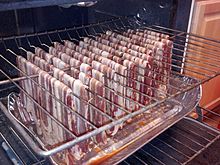
Maple brown sugar five spice bacon
jerky about to be oven-cured
Bacon has been gaining popularity over the past decade.
[86] It has become a
fad on the
internet.
[87]
Epic Meal Time
Main article:
Epic Meal Time
Epic Meal Time, a cooking show based on
YouTube, features bacon in many of their episodes. In one episode entitled
Bacon Tree,
Epic Meal Time creates a tree made out of bacon using over 2,000 strips of bacon.
[88] In another episode entitled
Boss Bacon Burger, over 400 strips of bacon are used to make a gigantic
hamburger with bacon and other toppings.
[89]
Rhett and Link
Main article:
Rhett and Link
On May 29, 2012, the YouTubers Rhett and Link published a comedy video promoting the
topical application of bacon as a cure-all. The video, "Rub Some Bacon on It," had received over nine million views in October 2015.
[90]




































